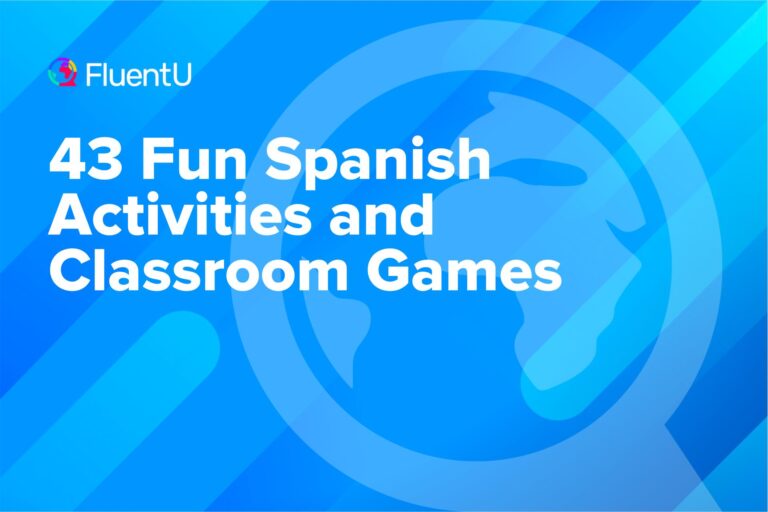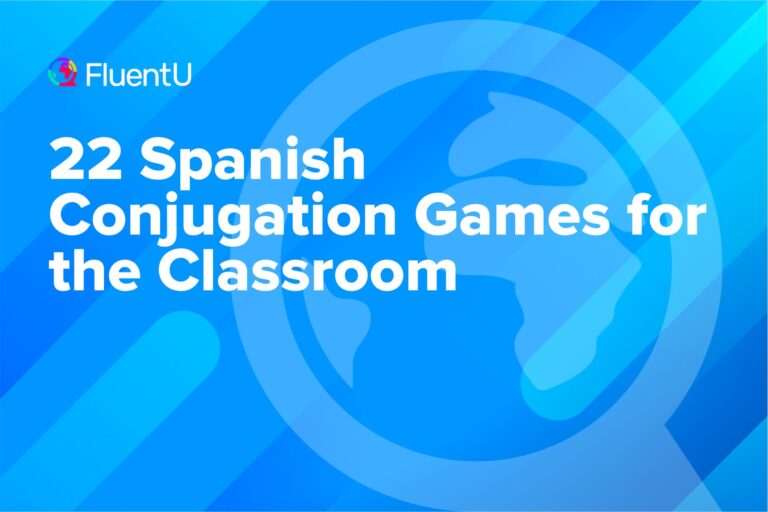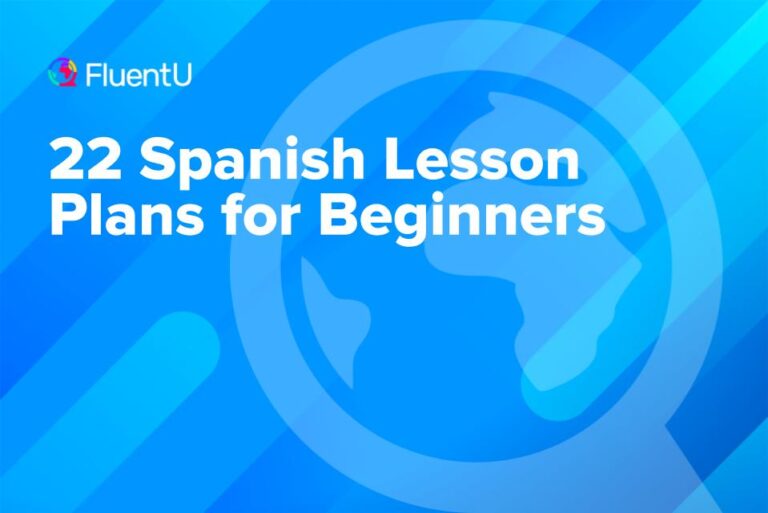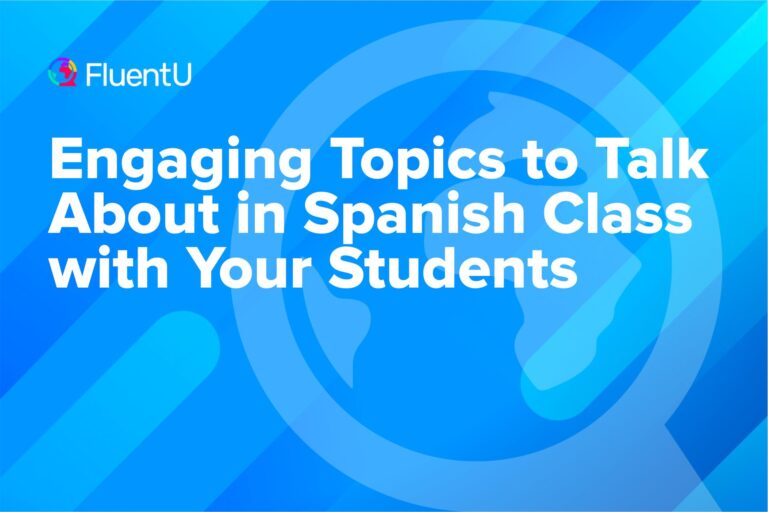Contents
- 1. Incorporate Co-curricular Lessons
- 2. Use Fun Oral Activities for Conversation Practice
- 3. Teach Culture, Vocabulary, Writing and Speaking with Food
- 4. Play Games for Greater Student Engagement
- 5. Plan with the Objectives in Mind
- 6. Teach with Practical, Task-based Instruction
- 7. Prioritize Spanish Reading Materials
- 8. Use Technology to Enhance Learning
- And One More Thing…
The Best Way to Teach Spanish: 8 Techniques

Teaching Spanish can be one of the most rewarding experiences. But sometimes, the constant pressure to make a foreign language accessible for your students can be overwhelming.
Fortunately, there are ways to incorporate new ideas, methods, lessons and resources that will make your class engaging and effective. Here are eight techniques for the best ways to teach Spanish.
Download: This blog post is available as a convenient and portable PDF that you can take anywhere. Click here to get a copy. (Download)
1. Incorporate Co-curricular Lessons
Integrating curricula to broaden students’ views and experiences is one of the most exciting and impactful ways to engage students and really solidify their language learning.
Combining aspects of your Spanish curriculum with another subject shows that Spanish goes beyond the classroom and is relevant in other areas. As a teacher, co-curricular lessons also allow you to incorporate activities that cater to multiple learning styles in the same lesson.
To try co-curricular lessons in your Spanish classroom, start by talking to your colleagues to see who would be open to the idea of an integrated lesson. You can discuss:
- interesting topics you could address
- concepts that involve both subject areas
- what students are currently learning in each class
Take Spanish and art, for example. Teaching Spanish involves exposing your students to culture. Art is a big part of the culture of a country and something that is typically covered often in the Spanish classroom.
I had the most success with co-curricular teaching when I collaborated with an art teacher as part of our study of the Day of the Dead. We conducted a week-long integrated lesson, combining Spanish and art classes and dividing material across days and concepts addressed by both subject areas.
My co-teacher and I taught the content in Spanish and English, addressing language, culture and art together. Our Spanish art project activities included making masks, designing celebration banners and researching customs.
When planning for co-curricular lessons, it’s important to tailor the experience to what works for the classroom, number of students and content. But this is something that anyone can do!
2. Use Fun Oral Activities for Conversation Practice
Students often express anxiety about speaking Spanish and conversing with the teacher and with other students. This is a big and crucial hurdle that we have to help our students jump over as they learn their foreign language.
Often, surprising students with unexpected Spanish conversation can make them shut down and shy away from speaking. On the other hand, when conversation time is expected and prepared for, students are less likely to turn into a big ball of nerves.
The best way to teach Spanish speaking is to take the fear out of it! Here are some tips:
- Direct the conversation. Choose specific topics and guided questions from current class objectives. Have students work together to become familiar with the topic and prepare, first with each other and then with you.
- Share the assessment rubric. Pass out the standards you’ll use to grade students to help guide them and show them what they can improve on ahead of time. Make sure it’s easy to use and understand.
- Aim for a lighthearted environment. Make the classroom feel safe and fun, and be sure all feedback is constructive. Focus on encouragement from classmates and the teacher, rather than picking out errors, whenever possible.
Try to get students to focus on improving their own skills each time they speak in Spanish. Consistently using a certain rubric will ensure that you focus on positive feedback to give each student based on how they perform at their own personal conversational level.
3. Teach Culture, Vocabulary, Writing and Speaking with Food
We could talk all day about different countries and their customs, but that doesn’t compare to actually tasting what it would be like to be there.
Sometimes the best way to learn is through different sensory experiences. And who doesn’t love food?!
You can broaden your students’ cultural experience while incorporating vocabulary, writing and speaking—without even leaving the classroom—by designating one or two days each month to culture- or country-specific content and activities.
Have monthly sign-ups for students to bring foods or ingredients so that there’s plenty of time before the designated day. Focus the lesson around what’s relevant to your students’ level and class. For instance:
- Lower-level classes could have a food-inspired Spanish vocabulary lesson
- Upper-level classes can practice recipe writing and cooking demonstrations (in Spanish!)
These lessons turn your classroom into another country and immerse your learners in various aspects of Spanish culture. Even better, engaging all the senses helps students retain content and enjoy themselves while they learn.
4. Play Games for Greater Student Engagement
I’m not just talking about typical classroom games. You can actually use project-based learning to allow students to work together and put what they’re learning to use outside of the textbook.
One idea for a project-based activity that will engage your students and pique their creativity is game design! Here’s how:
- Ask students to work in small groups to design their own board games.
- Game instructions must be in Spanish. They need to be understandable so that other student groups can successfully set up and play the games.
- Teach the relevant lesson with vocabulary and grammar content, then allow in-class time for students to brainstorm and make their games.
- Designate time for groups to trade games. They must work entirely in Spanish to set up and play the games created by their classmates.
- You can ask students to rate the games, ease of understanding the instructions, etc.
This project for your Spanish class is relatively simple in terms of materials required, and the payout is outstanding. Students are writing, conversing and interacting in Spanish, all while having fun playing games they designed themselves.
5. Plan with the Objectives in Mind
With backward design, you’ll set big teaching objectives before planning lessons and organizing materials. It’s a way to design curriculum that focuses on the goals and outcomes you want your students to achieve.
After enumerating those goals, you’ll move on to the content. This is typically where teachers start planning their units, based around concepts like “introductions and greetings,” “business vocabulary” or “conjugating verbs in the Usted (you, formal) form.”
To try out backward design yourself, figure out your end goal(s) and then consider how to measure student mastery. Then plan the individual lessons that take both the goals and assessments into consideration.
Let’s go over an example:
- Final objective: Students will be able to conduct a job interview in Spanish.
- Assessment: An interview role-play that follows a typical speaking rubric.
- Lesson planning: Students will likely need one to two weeks of preparation to successfully complete the assessment, so lessons will include professional vocabulary, practice writing dialogues using professional language, etc.
Knowing that overarching goal from the beginning ensures that all the lessons and activities are purposeful.
Backward design works for all grades, ages and language levels. However, because it relies on advanced planning for quizzes and tests, it works best if you’re able to try it at the beginning of a term, rather than partway through.
6. Teach with Practical, Task-based Instruction
Task-based instruction lets teachers emphasize real-life scenarios by allowing students to complete tasks in Spanish.
Instead of simply asking your students to learn a list of vocabulary words about nature, they can present a news report about the effects of pollution on their local park. Or, instead of watching a video about folk songs in Mexico, they’ll learn the songs themselves and sing them in class.
To incorporate task-based activities in your lessons, remember to consider the interests of your students. It often helps to have a few activities students can choose from in order to differentiate as well.
For example, one group of students might decide to write and perform a song, while others will create a video and others will write and illustrate a poem.
Below are some additional tips for using task-based instruction in your class:
- Make sure students are invested in the activity. For writing a report on the effects of pollution in the local park, first ask why this task is important to them. Identifying the practical and/or personal elements of the task is a great way to ensure buy-in.
- Help students break their task into manageable items of a to-do list. This helps them stay focused and strengthen their organizational skills.
- Don’t use task-based activities for every lesson! These can be high-energy, though doing them too often may also make the pace of the class feel stagnant.
7. Prioritize Spanish Reading Materials
Text-based instruction emphasizes reading comprehension skills by giving students different kinds of texts and allowing deeper learning to take place as the students understand for themselves how the different texts function.
The teacher must carefully choose the Spanish reading material while sequencing the curriculum. They must also provide lots of guidance and scaffolding to ensure comprehension of the readings.
For example, students in a beginner-level class might read an easy short story in Spanish or another lower-level text, while advanced Spanish students might read book reviews in El País.
Students may also read song lyrics or poetry in Spanish, so they can learn how the rhythms of texts vary and have different purposes.
The following tips can help you bring text-based learning into your Spanish classroom:
- Before you plan a bunch of text-focused lessons, try just a few to see if it works well for your class.
- Offer your students opportunities to practice using their Spanish dictionaries. This will help build their confidence and encourage them to look up what they don’t understand.
- Use authentic Spanish materials. Many are available online for free—BBC Mundo is a great place for news articles, for example. Even a household item with Spanish text or instructions works!
8. Use Technology to Enhance Learning
Planning lessons that incorporate educational apps, videos, websites and other online resources is one of the best ways to teach Spanish.
A teacher who wants to include tech tools might ask students to download an app like Duolingo for easy screen-time learning, personalized review and mini-targeted practice sessions.
There are also numerous flashcard apps available online. Sites and programs Quizlet and Anki, for example, can be used together in class or individually at home, depending on your students, their study needs and available resources.
Further, you can include language learning programs in your classroom to enhance student engagement and retention. With FluentU, for instance, you can present topics or share cultural insights using authentic Spanish videos.
The videos are made by and for native speakers, so you can be sure the vocabulary, grammar and subtitles are accurate. You can watch videos as a class, assign content to students directly and much more.
You can stay up to date on current tools with the magazine Tech and Learning. You can also check out this post for more ways to use technology in your Spanish classroom.
We hope you appreciate these strategies for making the most out of every class you teach and incorporating different ways of teaching to make Spanish more accessible for your students!
Buena suerte!
Download: This blog post is available as a convenient and portable PDF that you can take anywhere. Click here to get a copy. (Download)
And One More Thing…
If you've made it this far that means you probably enjoy learning Spanish with engaging material and will then love FluentU.
Other sites use scripted content. FluentU uses a natural approach that helps you ease into the Spanish language and culture over time. You’ll learn Spanish as it’s actually spoken by real people.
FluentU has a wide variety of videos, as you can see here:

FluentU brings native videos within reach with interactive transcripts. You can tap on any word to look it up instantly. Every definition has examples that have been written to help you understand how the word is used. If you see an interesting word you don’t know, you can add it to a vocab list.

Review a complete interactive transcript under the Dialogue tab, and find words and phrases listed under Vocab.

Learn all the vocabulary in any video with FluentU’s robust learning engine. Swipe left or right to see more examples of the word you’re on.

The best part is that FluentU keeps track of the vocabulary that you’re learning, and gives you extra practice with difficult words. It'll even remind you when it’s time to review what you’ve learned. Every learner has a truly personalized experience, even if they’re learning with the same video.
Start using the FluentU website on your computer or tablet or, better yet, download the FluentU app from the iTunes or Google Play store. Click here to take advantage of our current sale! (Expires at the end of this month.)








